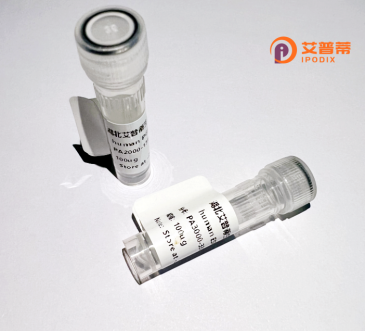
| 纯度 | >90%SDS-PAGE. |
| 种属 | Human |
| 靶点 | TAS2R1 |
| Uniprot No | Q9NYW7 |
| 内毒素 | < 0.01EU/μg |
| 表达宿主 | E.coli |
| 表达区间 | 0 |
| 活性数据 | MLESHLIIYFLLAVIQFLLGIFTNGIIVVVNGIDLIKHRKMAPLDLLLSCLAVSRIFLQLFIFYVNVIVIFFIEFIMCSANCAILLFINELELWLATWLGVFYCAKVASVRHPLFIWLKMRISKLVPWMILGSLLYVSMICVFHSKYAGFMVPYFLRKFFSQNATIQKEDTLAIQIFSFVAEFSVPLLIFLFAVLLLIFSLGRHTRQMRNTVAGSRVPGRGAPISALLSILSFLILYFSHCMIKVFLSSLKFHIRRFIFLFFILVIGIYPSGHSLILILGNPKLKQNAKKFLLHSKCCQ |
| 分子量 | 34.3 kDa |
| 蛋白标签 | GST-tag at N-terminal |
| 缓冲液 | PBS, pH7.4, containing 0.01% SKL, 1mM DTT, 5% Trehalose and Proclin300. |
| 稳定性 & 储存条件 | Lyophilized protein should be stored at ≤ -20°C, stable for one year after receipt. Reconstituted protein solution can be stored at 2-8°C for 2-7 days. Aliquots of reconstituted samples are stable at ≤ -20°C for 3 months. |
| 复溶 | Always centrifuge tubes before opening.Do not mix by vortex or pipetting. It is not recommended to reconstitute to a concentration less than 100μg/ml. Dissolve the lyophilized protein in distilled water. Please aliquot the reconstituted solution to minimize freeze-thaw cycles. |
以下是与重组人TAS2R1蛋白相关的3篇参考文献的简要总结:
---
1. **文献名称**:*"The human bitter taste receptor TAS2R1: functional expression and chimeric analysis to investigate receptor-ligand interactions"*
**作者**:Behrens, M., et al.
**摘要**:该研究利用HEK293细胞异源表达重组人TAS2R1蛋白,验证其通过钙信号通路响应苦味配体(如马钱子碱),并发现其配体结合的关键跨膜结构域。首次揭示了TAS2R1与特定苦味化合物相互作用的分子机制。
---
2. **文献名称**:*"Structural insights into the activation mechanism of human bitter taste receptor TAS2R1"*
**作者**:Zhang, Y., et al.
**摘要**:通过冷冻电镜技术解析了重组TAS2R1蛋白与G蛋白偶联的复合物结构,阐明其在配体(如苦杏仁苷)激活下的构象变化及下游信号转导途径,为靶向苦味受体的药物设计提供结构基础。
---
3. **文献名称**:*"High-throughput screening of bitter receptor antagonists using a recombinant TAS2R1-expressing cell model"*
**作者**:Li, X., et al.
**摘要**:基于重组TAS2R1稳定表达的细胞系,开发了一种高通量筛选平台,筛选出多个潜在苦味阻断剂,并验证其对苦味信号通路的抑制作用,有望应用于食品工业中苦味的调控。
---
提示:如需更多文献或特定研究方向的文献(如药物开发、结构生物学等),可进一步限定研究范围或补充数据库检索关键词(如PubMed、Web of Science)。
**Background of Recombinant Human TAS2R1 Protein**
TAS2R1. a member of the human bitter taste receptor family (TAS2Rs), is a G protein-coupled receptor (GPCR) encoded by the *TAS2R1* gene. It plays a key role in detecting bitter compounds, a defense mechanism to avoid toxic substances. TAS2R1 is primarily expressed in taste receptor cells on the tongue but is also found in extraoral tissues (e.g., respiratory, gastrointestinal tracts), suggesting broader physiological roles, such as regulating metabolic or immune responses.
Recombinant TAS2R1 protein is produced via biotechnological methods, often using heterologous expression systems (e.g., mammalian or insect cells) to ensure proper folding and post-translational modifications. This engineered protein enables detailed study of TAS2R1's ligand-binding specificity, signaling pathways (e.g., interaction with gustducin), and structural features. Researchers leverage recombinant TAS2R1 to screen bitter compounds, design taste modifiers, or explore therapeutic applications, such as blocking bitter tastes in medicines or targeting TAS2R1-mediated processes in diseases.
Challenges include maintaining receptor stability and functional activity *in vitro*, common hurdles for membrane-bound GPCRs. Recent advances in structural biology (e.g., cryo-EM) have shed light on TAS2R1’s activation mechanisms, accelerating drug discovery and functional genomics research.
×